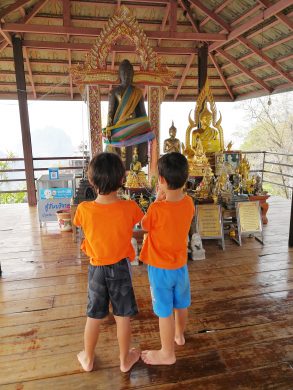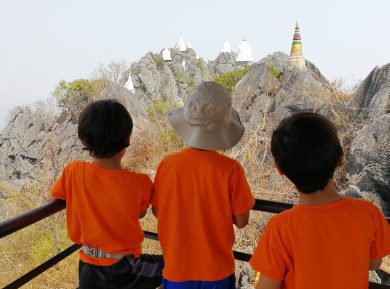
Northern Exposure – PH2.5 and all…
Getting to the base of Wat Chalermprakiat was easy enough: a one hour drive north of Lampang on a newly paved road. From there, things got more challenging.
First, we piled in the back of a 4WD songthaew for a perilous drive up a nearly unclimbable access road. Next, we trekked 25 minutes up an even steeper rocky trail to a small cluster of pagoda like temples. As we climbed up the wooden stairs to a viewing platform, the boys gasped with wonder. It looked like the CGI backdrop for a martial arts movie: a cluster of white stupas perched atop a knifelike, grey karst ridge. How on earth had they had been built? Helicopters? Levitating monks? Kung fu pandas? Some of the stupas looked completely inaccessible, balanced on pinnacles well below the main ridge. Yet a new stupa was being built, its aluminium core gleaming like a Russian Orthodox dome. On a clear day, we probably could have seen all the way to the mountains separating Lampang province from Chiang Mai to the west and Phrae to the east. Here in Thailand’s North, every valley is a province, every mountain pass a border. Even with the shroud of smoke, the views across the valley below were incredible. Instead of spoiling the views, the ghostly fingers curling around the stupas added an air of mystery to the already magical scene. “Let’s just pretend the smoke is mist,” Nori suggested, snapping photos.

We had picked the wrong time to visit the North. Each year in April, before the rains come, farmers burn their fields to clear
During our seven

Old Lampang was one of the prettiest towns in Thailand. From our hotel, we drove north over the Wang River into a neighbourhood of traditional wooden homes, temples and small shops. We took a requisite ride in a horse drawn carriage – one of Lampang’s tourism icons. At Wat Phra Kaew Don Tao, I warned the boys that they needed to stay very quiet because this temple was patrolled by monks with sticks who whacked misbehaving children. Tai and Logan didn’t fall for my ruse, but Drake and Kiva were silent and alert. “Dad! A monk!” Drake whispered, zipping behind me. “But he doesn’t have a stick?” “No. The young ones are friendly,” I deadpanned. “They only get sticks when they become full monks.” “Oh,” he replied. That made perfect sense to him. Lampang’s “Walking Street” night market was one of Thailand’s longest, with incredible street food stalls and a pleasantly random selection of clothes, toys, and bric-a-brac. Nori and I continued our research on khao soi, while the boys batted each other with balloons-on-sticks that someone had handed them. Early the next morning, we were the first customers at Khao Soi Islam, a deliciously different take on the ubiquitous dish.

The provincial capital of Phrae was 90 minutes away, in the next valley to the East. While Nori navigated the curving highway over the forested pass, I read to the boys from a Geology textbook: all about igneous, metamorphic and sedimentary rocks. Throughout our six-month “Big Twip,” we found that ‘education time’ was easiest to do in the car – mainly because the kids were trapped. When we pulled over to switch drivers, the turnout was occupied by a policeman with a radar gun.
He looked at us with confusion. Perhaps he thought we were turning ourselves in? Phrae town felt very small and very slow. We drove into the centre of the old, walled city and parked next to the teal painted teak mansion of the “Prince of Phrae.” The city boasts a number of these brightly coloured, ornately-trimmed, historic wooden homes. A woman selling snacks nearby encouraged us to visit the museum inside (“it’s free!”) but I knew that perusing the personal effects of

The Nan River forms in the rugged, green mountains of Doi Phu Kha National Park and flows south in a thousand meanders through a 20 mile wide, heavily farmed valley. Nan town sat astride the river in the very heart of the province. Given its setting, I had expected that Nan would be just like Pai: busloads of backpackers in fisherman’s pants, yoga retreats and banana pancakes. But Nan felt well off the foreign tourist trail.
We kept looking for companies offering guided hikes or adventure tours and found few. Nan didn’t seem to realise that it could be the new hiking capital of the North. At night, the area around Wat Phumin and the night market was thronged with happy people enjoying a late meal in the cool evening air. Nori ordered a cup of gatee – fresh coconut ice cream laced with swirls of the coconut’s white, gelatinous inner flesh. I bought some marshmallow-slathered ‘Thai tacos’ for the boys and a few skewers of grilled pork (moo yang) for me. Lord will we miss Thailand’s night markets!
I couldn’t help noticing the large number of teenagers in tracksuits. It happened that the Thailand National Youth Games were being held in Nan that week. Groups of unusually tall girls giggled and snuck glances at handsome boys from other provinces. Knots of strutting boys tried their best to get the girls’ attention without being too obvious. The flirtation was charmingly innocent – no cat calls, no bad language, no obscene gestures. If the same event were held in the USA, the coaches and minders would have gone crazy trying to keep boys and girls from getting drunk and hooking up. It took three hours to drive from Nan to Phayao along some of the loneliest and prettiest highways we’ve experienced in Thailand. The scenery was overwhelmingly rural, with tiny, 7-11-less villages and fields of rice and corn extending to the foot of the hazy mountains. There were new signs up everywhere exhorting farmers to “Love the forest, don’t burn it!” or to “Stop burning!” but they weren’t working. Often we saw cones of grey smoke rising from new burns.

Phayao town sat on the Northeast shore of its namesake lake, a surprisingly large (but shallow) body of water whose Thai name, กว๊านพะเยา, suggested a certain swampiness. An attractive row of restaurants and hotels looked out to the water, where long-tail boats waited to take local tourists on short cruises. A bicycle path curved along the shoreline and various beautification projects were underway.
I liked Phayao



